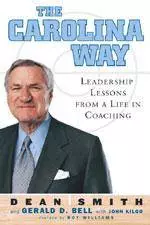University of North Carolina Athletics

The Carolina Way - Chapter 1 - Part 3
February 3, 2004 | Men's Basketball
Feb. 3, 2004
Introduction | Part 1 | Part 2
After a game my responsibility was to my players. After shaking hands with the opposing coach and some of his players, I ran to the dressing room. It was a time for me to be with my players and assistant coaches. Sometimes a television producer intercepted me on the way to the dressing room and said his network wanted me for a quick interview. I almost always declined. TV didn't understand, but my players did.
You seldom saw North Carolina players arguing with one another or scolding one another on the court. Now, a senior might speak up if he saw something he didn't like. But it was done in the right way. I didn't embarrass them publicly, and they didn't point fingers at one another. It was our cast-the-first-stone theory.
Even though I came out of college accredited to teach high school math, I wasn't hung up on statistics. We used them to prove a point, but seldom for any other purpose. They can be very misleading. For example, if a player was credited with three steals, that might look good on a stat sheet, but he could have played poorly on defense. He could have gambled three or four other times and failed to get a steal and given his opponent easy baskets. That kind of defensive inconsistency wasn't good for the team, no matter what statistics indicated.
I was interested in how many points North Carolina scored, but not in individual scoring. Let's say an opposing player took thirty shots and made nine. He led the game in scoring and might have been named player of the game by television announcers. But that shooting percentage-nine shots made out of thirty taken-was good for North Carolina. We didn't care how many points an opposing player scored as long as his shooting percentage was low. Our coaches graded every possession of each game. It was tedious work and took more than five hours to grade game tapes, but we thought it was important. We rewarded unselfish acts that helped the team: good defense, setting effective screens, diving on the floor in pursuit of the ball, assists, blocked shots, deflected passes. We didn't even want the official game statistics kept for the media to be given to our players because they stressed points scored over all other aspects of the game.
We kept many statistics in practice. Our managers recorded three-point shots attempted and made in each practice. We did the same for foul shots. We wanted to know who our best shooters were over an extended period of time. This was our way of using solid information to guide our strategies.
I believed in being honest with our players. I wasn't going to con them, that was for sure. Sometimes it meant saying things that I didn't enjoy. I told one player after his sophomore season that he might want to transfer to another school where he'd have a better chance to play. He was a terrific young man who had been an outstanding football player in high school and had been offered scholarships by some big-time football programs. His love was basketball, though, and he had accepted our scholarship offer after we scouted him and liked his potential. However, things had not gone that well for him in basketball during his freshman and sophomore seasons. I knew how competitive he was and was concerned that he might be unhappy sitting on our bench for four years. -You're great for our team, and we'd love for you to stay," I told him before he left Chapel Hill for summer vacation after his sophomore year. -But you're our thirteenth man, and I don't see things improving much for you as far as playing time goes. Think about it for a week, and let me know what you decide. We'll support your decision either way."
He called me in a week and said he was going to return to North Carolina. I was delighted. He spent hours and hours each day that summer working on his shot, his ballhandling, all his basketball skills. I couldn't believe my eyes when practice opened on October 15. He was vastly improved. He won a starting position for us and made All-ACC first team before he graduated. He also played professionally in the old American Basketball Association.
I learned from my players too. I never penciled in a starting lineup during our planning work in the summer. That would have been unfair to players who had worked hard in the off-season and improved. It's amazing how much some young people can improve from one year to the next.
I was always excited to open practice on October 15. Our players were fired up and anxious to get started. They started out even in my eyes. The six weeks of preseason practice was my favorite time of the year. It was a special time to teach and build a team from scratch. Our team chemistry as well as other important elements was determined during those six weeks.
To sum up, if you asked me to define my coaching and leadership style, I'd describe myself as an open-minded dictator. My basketball philosophy boils down to six words: Play hard; play together; play smart.




.png&width=36&height=36&type=webp)





